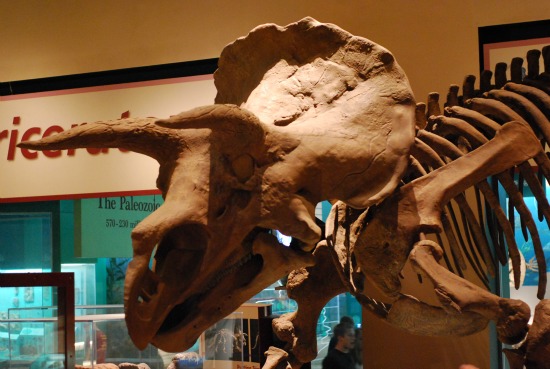Triceratops Wasn’t Toxic
Triceratops was an awesome dinosaur, but, despite one site’s claim, it wasn’t equipped with poisonous quills
![]()
Triceratops was an A+ dinosaur. But, awesome as the hulking ceratopsid was, it didn’t have mutant superpowers. Indeed, despite a website’s claim to the contrary, there’s no evidence that this three-horned behemoth defended itself with poisonous quills.
Even though it was posted over a year ago, I’ve received a few emails this week asking about a Listverse post by user “TyB” titled “Top 10 Dinosaurs That Aren’t What They Were.” For the most part, the list is a simple summary of how new discoveries and ideas have revitalized images of dinosaurs. When the article gets to Triceratops, though, the scientific accuracy careens off the rails.
Rather than being covered in smooth, wrinkly skin, the article states, Triceratops had “alligator-like, flat scales, called scutes, on its belly, and the rest of its body was covered in large scales and knobs.” I don’t know of any published study on Triceratops’ body covering, but it wouldn’t be surprising if, like other dinosaurs, Triceratops had bumpy skin with larger knobs or ornaments here and there. But here’s where things get strange:
Its back and tail also had a series of weird, fist-sized bumps, each one holding a nipple-like structure which has yet to be explained by scientists. These structures may very well be anchoring points for porcupine-like quills, like those found on Triceratops’ older cousin, Psittacosaurus. Or perhaps, some scientists suggest, they were poison glands, oozing toxins to protect the Triceratops’ hindquarters from T-Rex attacks.
I have no idea what this blogger is talking about. I had never heard the idea of a poisonous Triceratops before reading the list, and I don’t know of any paleontologist who has advocated such a notion. I think I know where the post’s author got the basis for their idea, though. For years, there have been rumors of a Triceratops–now on display at the Houston Museum of Natural Science–that was preserved with skin impressions and possible evidence of bristles along the tail. The scuttlebutt, along with evidence of feather-like bristles in the archaic ceratopsian Psittacosaurus, spurred artists to start putting tufts of quills on Triceratops tails.
No one has formally published a description of these structures, though. Whether they’re truly bristles, some other true body covering or a preservational artifact is unknown. It’s not unreasonable to think that Triceratops had patches of bristles, but the truth is that there’s no positive evidence that such ornamentation actually adorned the dinosaur, either.
But I’m confounded by the suggestion that the base of the quills provided space for “poison glands.” Bristles on Triceratops are iffy to start with, and no one has ever demonstrated that dinosaurs used venom or other toxins for defense. In 2009, one group of researchers proposed that the feathered, sickle-clawed Sinornithosaurus had a venomous bite, but their suggestion was quickly refuted. There’s so evidence that dinosaurs were venomous, poisonous, toxic or otherwise relied on biological warfare. As far as I can tell, the toxic Triceratops is entirely the invention of the list’s author.
That’s not all. In the same post, the author states that “After examining the beak and jaws, paleontologists reached the conclusion that Triceratops may have been partially carnivorous, probably scavenging after T-Rex, or even scaring smaller predators away from their kills.” Again, no one has actually studied this in detail, but, unlike the poison hypothesis, this idea is actually plausible.
Paleontologist and artist Mark Witton raised this point in a description of a gorgeous Styracosaurus illustration he drew a few years ago. As Witton pointed out, the scissor-like jaws of big ceratopsids were probably capable of slicing through flesh as well as plants, and it’s not unreasonable to think that these dinosaurs occasionally picked over meaty carcasses to supplement their diets with some protein. After all, as paleontologist Darren Naish has illustrated, cows and deer do the same thing today. Herbivores can indulge in a meaty meal, just as carnivores sometimes chomp fruit and greens. What we need now is someone to model how a Triceratops skull would handle munching on flesh and bone to put some more science behind the speculation.
/https://tf-cmsv2-smithsonianmag-media.s3.amazonaws.com/accounts/headshot/RileyBlack.png)

/https://tf-cmsv2-smithsonianmag-media.s3.amazonaws.com/accounts/headshot/RileyBlack.png)